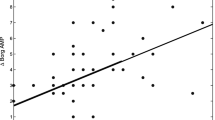Abstract
The role of airway inflammation in mediating airflow obstruction in persons with chronic traumatic tetraplegia is unknown. Measurement of the fraction of exhaled nitric oxide (FeNO) affords a validated noninvasive technique for gauging the airway inflammatory response in asthma, although it has never been assessed in persons with tetraplegia. This study was designed to determine the FeNO in individuals with chronic tetraplegia compared with that in patients with mild asthma and healthy able-bodied individuals. Nine subjects with chronic tetraplegia, seven subjects with mild asthma, and seven matched healthy able-bodied controls were included in this prospective, observational, pilot study. All subjects were nonsmokers and clinically stable at the time of study. Spirometry was performed on all participants at baseline. FENO was determined online by a commercially available closed circuit, chemiluminescence method, using a single-breath technique. Subjects with tetraplegia had significantly higher values of FeNO than controls (17.72 ± 3.9 ppb vs. 10.37 ± 4.9 ppb; P ≤ 0.01), as did subjects with asthma (20.23 ± 4.64 ppb vs. 10.37 ± 4.9 ppb, P ≤ 0.001). There was no significant difference in FeNO between subjects with tetraplegia and those with asthma (17.72 ± 3.9 ppb vs. 20.23 ± 4.64 ppb, P ≤ 0.27). Individuals with chronic tetraplegia have FeNO levels that are comparable to that seen in mild asthmatics and higher than that in healthy able-bodied controls. The clinical relevance of this observation has yet to be determined.

Similar content being viewed by others
References
Dicpinigaitis PV et al (1994) Bronchial hyperresponsiveness after cervical spinal cord injury. Chest 105(4):1073–1076
Singas E et al (1996) Airway hyperresponsiveness to methacholine in subjects with spinal cord injury. Chest 110(4):911–915
Grimm DR et al (1999) Airway hyperresponsiveness to ultrasonically nebulized distilled water in subjects with tetraplegia. J Appl Physiol 86(4):1165–1169
Schilero GJ, Grimm DR, Bauman WA, Lenner R, Lesser M (2005) Assessment of airway caliber and bronchodilator responsiveness in subjects with spinal cord injury. Chest 127(1):149–155
Almenoff PL, Alexander LR, Spungen AM, Lesser MD, Bauman WA (1995) Bronchodilatory effect of ipratropium bromide in patients with tetraplegia. Paraplegia 33(5):274–277
Zitt M (2005) Clinical applications of exhaled nitric oxide for the diagnosis and management of asthma: a consensus report. Clin Ther 27(8):1238–1250
Barnes PJ, Belvisi MG (1993) Nitric oxide and lung disease. Thorax 48(10):1034–1043
Barnes PJ, Liew FY (1995) Nitric oxide and asthmatic inflammation. Immunol Today 16(3):128–130
Kharitonov SA et al (1994) Increased nitric oxide in exhaled air of asthmatic patients. Lancet 343(8890):133–135
Miller MR et al (2005) Standardisation of spirometry. Eur Respir J 26(2):319–338
The official statement of the American Thoracic Society (1999) Recommendations for standardized procedures for the on-line and off-line measurement of exhaled lower respiratory nitric oxide and nasal nitric oxide in adults and children. Am J Respir Crit Care Med 160:2104–2117
DeVivo MJ, Black KJ, Stover SL (1993) Causes of death during the first 12 years after spinal cord injury. Arch Phys Med Rehabil 74(3):248–254
Jackson AB, Groomes TE (1994) Incidence of respiratory complications following spinal cord injury. Arch Phys Med Rehabil 75(3):270–275
Fischer A et al (1993) Nitric oxide synthase in guinea pig lower airway innervation. Neurosci Lett 149(2):157–160
Asano K, Chee CBE, Gaston B, Lilly CM, Gerard C, Drazen JM, Stamler JS (1994) Constitutive and inducible nitric oxide synthase gene expression, regulation and activity in human epithelial cells. Proc Natl Acad Sci USA 91:10089–10093
Barnes PJ, Belvisi MG (1993) Nitric oxide and lung disease. Thorax 48:1034–1043
Dweik RA, Laskowski D, Abu-Soud HM, Kaneko FT, Hutte R, Stuehr DJ, Erzurum SC (1998) Nitric oxide synthesis in the lung: regulation by oxygen through a kinetic mechanism. J Clin Invest 101:660–666
Di Maria GU, Spicuzza L, Mistretta A (2000) Role of endogenous nitric oxide in asthma. Allergy 55(Suppl 61):31–35
Acknowledgments
This work was funded by a Rehabilitation Research and Development (RR&D) Service Career Development award (B4335 V) & RR&D Center of Excellence for the Medical Consequences of Spinal Cord Injury (B4162C). The authors thank The James J. Peters Medical Center, Bronx, NY, and Department of Veterans Affairs Rehabilitation Research and Development service for their support.
Author information
Authors and Affiliations
Corresponding author
Rights and permissions
About this article
Cite this article
Radulovic, M., Schilero, G.J., Wecht, J.M. et al. Exhaled Nitric Oxide Levels Are Elevated in Persons with Tetraplegia and Comparable to that in Mild Asthmatics. Lung 188, 259–262 (2010). https://doi.org/10.1007/s00408-009-9207-x
Received:
Accepted:
Published:
Issue Date:
DOI: https://doi.org/10.1007/s00408-009-9207-x




